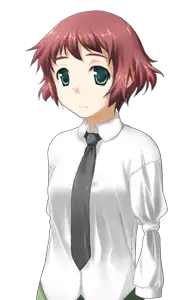Back about 10 years ago, I became interested in the idea of trying out a visual novel (VN for short). I had just learned about them and was curious as to what sort of stories you could tell with the style. Unfortunately, all I could find were either completely in Japanese with no translation to be found, available with translation, but costing upwards of $70, or pornographic to the extreme. It was wading through this morass that I came across a demo for a game called Katawa Shoujo. At first, my expectations weren’t too high. The only real reason I picked it up at all was because the demo was both free and in English. I really wasn’t expecting much. Boy was I wrong. The demo of Katawa Shoujo was amazing, painting a vivid picture of its characters and their troubles and experiences.
It also was just a demo. So I waited. And waited. Eventually, in 2012, the game finally came out. Where the demo made me laugh, the rest of the game made me cry and think, quite different from my first impression of the game. But what exactly is this game? And why would I be so hesitant to play it? The answer there lies in Katawa Shoujo’s origin.
Medical Background
The idea behind Katawa Shoujo started with a single page from the end of a Nausicaä: Of the Valley of the Wind doujin written by Raita Honjou, also known as RAITA. The page was simple concept art for a visual novel dating sim about girls with various disabilities. The page came to 4chan’s /a/ board, where a group of people decided to actually try and make the game a reality. The people interested in helping became Four Leaf Studios (4LS), naming themselves after the 4chan logo. The game began development in earnest in 2007, with the demo first launched on April 29, 2009. The demo consisted of the first act, introducing the various girls and their personalities. Katawa Shoujo would remain in development for another three years before finally being released on January 4, 2012, after about five years in development.
As you can probably see, the backstory of the game is not one you’d expect very positive results from. Inspired by an erotic doujin bonus page, created by people from 4chan, about dating girls with disabilities? Everything about the idea sounds terrible and exploitative. Even the name itself is questionable. ‘Katawa Shoujo’ means ‘Disability Girls’ in Japanese, but the word ‘Katawa’ is old fashioned and considered rude now. The English equivalent would be calling someone a “cripple”. Not a word you’d want to be using. And despite all these warnings, I still recommend the game to people. Why is that? The answer is simple: The writing.
Epidemiology
Spoilers for Katawa Shoujo to follow!
The story begins on a cold winter’s day, with the protagonist (named Hisao Nakai) standing in a snowy field one winter. His crush, a young woman named Iwanako, approaches him. She tells him that she also has a crush on him, and wonders if he would like to go out with her. Before Hisao can respond, his heart gives out. Literally. As it happens, Hisao was born with a severe congenital heart muscle deficiency and arrhythmia, specifically, Long QT Syndrome. It’s only after several surgeries and months in the hospital is he able to return to a ‘normal’ life, consisting of dozens of pills daily. During his hospital stay, he lost the majority of his friends and his crush. And to top it off, that his parents had enrolled him in a ‘special boarding school’ for other young people with disabilities without his knowledge. It’s no wonder Hisao begins the game very cynical and sardonic. After a short interlude, we are introduced to the main heroines of the game: Emi Ibarazaki, Hanako Ikezawa, Lilly Satou, Rin Tezuka, and Shizune Hakamichi. Each girl has a different disability, and each girl has a question associated with their personal story.

Emi’s question is “Can you stand up for yourself?” which is quite appropriate, considering she lost both of her legs below the knee in a car accident. Despite this setback, Emi is a bright and cheerful young woman, and one of the fastest members of the track team. (And, in a minor detail I adore, has very accurate running blades in the scenes we see her with.) If you choose to date her and follow her bath you begin to learn that Emi’s cheerful attitude and slightly flippant personality is hiding the fact that her father died in the same accident that cost her legs. She was incredibly close to her father, and ever since his death has kept everyone at a distance. Part of her route is trying to get her to open up to you.

Hanako’s question asks “Can you face your fears?”. This question seems fairly simple on the face of it, as Hanako’s disability relates to the severe burn scars covering half her body. Her house caught fire when she was eight years old, and both of her parents died trying to save her. This, combined with the fact that she was teased mercilessly through grade and middle school, have left her incredibly reclusive. However, as you play through her route you begin to see she has much more inner strength than her physical appearance belies. Indeed, the key to achieving her good ending is allowing her more independence and not constantly acting as her “white knight.”

“Can you see what I see?” is the question for Lilly’s route. Blind since birth, Lilly is poised, graceful, and the most classically beautiful of any of the main characters. She’s also confident and, as you later learn, her family comes from a wealthy background. She seems almost like a perfect, Mary Sue-ish character, and that’s where the issues lie. She is so stoic and reserved that she doesn’t ask or express any desire for help. In that sense, she’s almost the opposite of her close friend Hanako: Where Hanako appears fragile but has a core of inner strength that is untapped, Lilly appears completely composed at all times, even she secretly wishes someone would ask if she needed help.

Rin’s route asks the player “Can you seize the day?” which is a very different sort of question from most of the others so far. Then again, Rin is a very different sort of character. A birth defect left her with small stumps for arms, and surgeries since then have reduced them even more. She uses her feet for most everything, from eating to her true passion, painting. She’s also incredibly eccentric and has a habit of getting lost in thought. Like Emi, Rin comes across as reserved, but unlike Emi, Rin wants people to understand her. Unfortunately, due to her odd manner of speech and sometimes bizarre paintings, no one seems to quite grasp her. If the player follows her route, the way to unlock her good ending is not trying to understand her. Instead, its supporting her art and her desires.

The last girl, and my personal favorite, is Shizune. Her route asks “Can you tell me what you think?” Which isn’t exactly an easy task for her, as she’s been both deaf and mute since birth. She doesn’t let a little thing like that slow her down though, and with the help of her best friend and translator Shiina “Misha” Mikado, is both the class representative and one of two people on the student council. Shizune is also incredibly ambitious and competitive, trying to turn every social interaction into some sort of game or competition. Her personality would be hard enough to deal with at the best of times. With someone who can’t communicate without a translator close at hand, Shizune has a habit of driving people away. Her route is about her fear that she will drive everyone she cares about away.
Spoilers End Here
Prognosis
As you might be able to tell from that previous section, there’s a lot more going on in Katawa Shoujo than just ‘dating girls with disabilities’. 4LS consulted with medical experts during development, trying to find the best way to portray each girl’s disability, and it shows. Each of the girls is fully fleshed out character, with their own quirks, likes, and dislikes. Indeed, trying to treat the girls like they are fragile or need protecting is often times the fastest way to have them break up with you. The writing around the disabilities themselves is also top-notch, walking the fine line between “This is the only thing that matters about the character” and “A serious medical condition is just treated as a quirk.” Each of the girls has a unique perspective, and taken as a whole, they hammer the main moral of the game home, that being disabled doesn’t mean being helpless.
The writing for the supporting cast is top notch as well, from the school nurse to your misogynistic, conspiracy theory-crazed dorm mate. The animation and music are also beautiful. If you had to criticize the game about anything, it’s that some of the sex scenes in the game go on for a bit longer than really needed and yes, there are some sex scenes. Fortunately, you are able to disable them from the main menu if you don’t want to see them.
In the end, the thing I was most touched by when I played Katawa Shoujo was the pace of it. There was no rush, and the epiphanies happened naturally. I’ve since played other visual novels, and while some have been better, none of them have touched me quite like this free game from 4chan.

